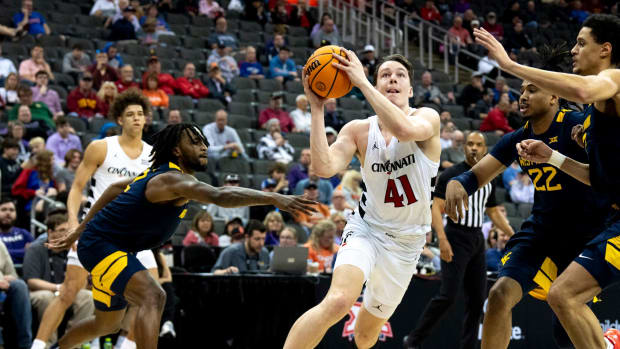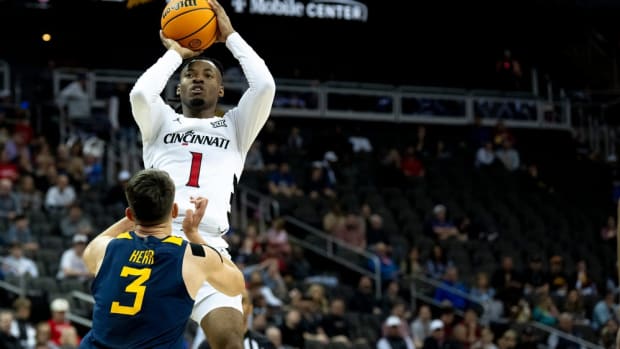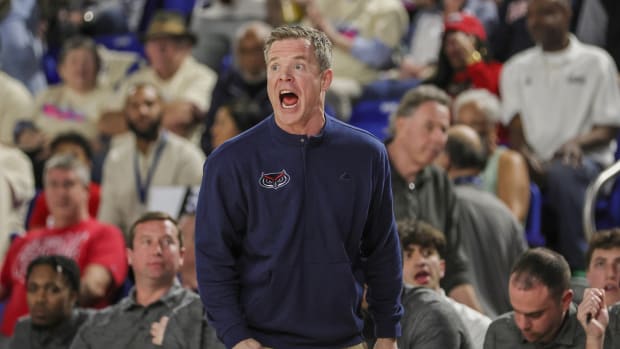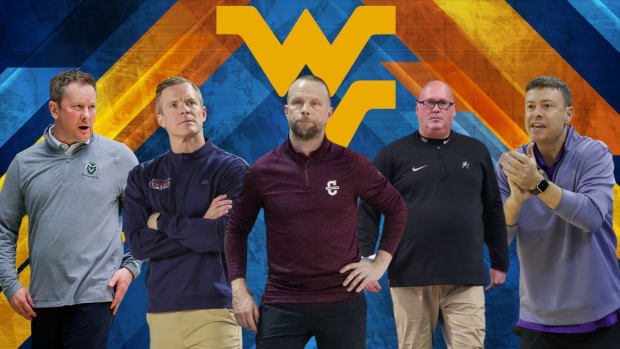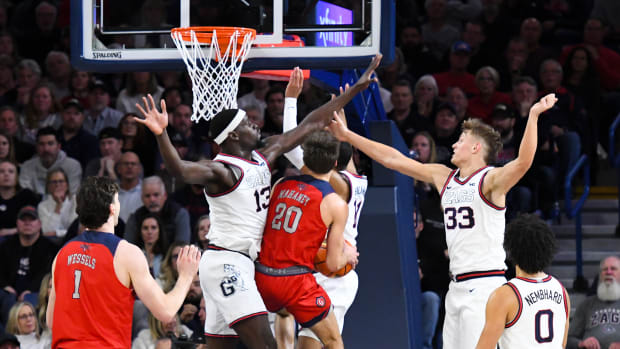Ten most disappointing teams this season
Get all of Zac Ellis’s columns as soon as they’re published. Download the new Sports Illustrated app (iOS or Android) and personalize your experience by following your favorite teams and SI writers.
Every college basketball team shares similar goals: A winning season, a conference championship and, eventually, a deep run in the NCAA tournament en route to national title. Success stories are what we love about college basketball, but winning, of course, is only one side of the coin. For every team that wins big in March, several others fall short of expectations, and even more miss out entirely on the NCAA tournament.
So who were this season’s most disappointing teams in college basketball? SI.com breaks down 10 programs, listed alphabetically, that fell short in 2015–16.
Connecticut (25–11, 11–7 AAC)
UConn missed the NCAA tournament in 2014–15—just one year after winning the national championship—but the program appeared poised for a deep tournament run this season. It returned a high-scoring backcourt in guards Daniel Hamilton and Rodney Purvis and added a hyped point guard signee in Jalen Adams. Plus, Seton Hall transfer guard Sterling Gibbs arrived with tons of potential. But a 9–10 record against top-100 teams had UConn on the bubble before it won the AAC tournament title. Coach Kevin Collie ‘s squad eventually earned a No. 9 seed in the NCAA tourney, but it had no business flirting with disaster on Selection Sunday in the first place.
• MORE: The 10 most surprising players this year
Georgetown (15–18, 7–11 Big East)
Given Villanova’s run to the national title, it seems odd to remember Georgetown kicked off the season as perhaps the most talented team in the Big East. Senior guard D’Vauntes Smith-Rivera was an all-conference talent, while Jessie Govan and Marcus Derrickson were highly touted recruits. But that roster morphed into an offense that ranked 219th or worse in turnover percentage (19.1) and offensive rebounding percentage (28.3). The Hoyas went on to snag just two top-50 wins during the second half of the season and lost nine of their final 10 games in Big East play. In the end, Georgetown finished with its worst record in 12 seasons under John Thompson III.
LSU (19–14, 11–7 SEC)
When the No. 1 recruit in the country, Ben Simmons, signed with LSU, he no doubt expected a trip to the postseason in what was likely to be his only college season. Instead, the Tigers suffered six sub-100 RPI losses—including a season-ending 71–38 bludgeoning from Texas A&M in the SEC tournament—and missed the Big Dance entirely. The program then opted to forgo its ticket to the NIT. LSU opened the season needing to replace NBA-bound big men Jarell Martin and Jordan Mickey, but Simmons’s talent—alongside returning guards Josh Gray, Keith Hornsby and Tim Quarterman—seemed like enough for a tournament run. Instead the Tigers left a host of hype on the table.
Michigan State (29–6, 13–5 Big Ten)
This season Tom Izzo’s club won 29 games and claimed the Big Ten tournament championship behind guard Denzel Valentine, the AP player of the year, and a senior-laden roster. But Michigan State’s untimely loss in the NCAA tournament will now define that campaign for years to come. No. 15–seeded Middle Tennessee State shocked the No. 2–seeded Spartans with a 90–81 stunner in the first round, considered by many the biggest March Madness upset in history. Few coaches are as tournament-tested as Izzo, but a Michigan State team that entered March Madness winners of 13 of its last 14 games headed home far earlier than expected.
NC State (16–17, 5–13 ACC)
The consistency of four straight NCAA tournament bids under Mark Gottfried wasn’t enough to prevent what happened to NC State this season. Despite an offense that ranked 31st in adjusted efficiency, defense plagued the Wolfpack as they finished 5–13 in conference play along with nonconference losses to the likes of William & Mary and Arizona State. Despite having the league’s leading scorer, Anthony Barber (23.5 points per game), the program’s 16–17 record was its worst under Gottfried and better than just two ACC foes, Wake Forest (11–20) and Boston College (7–25).
South Carolina (25–9, 11–7 SEC)
How many times does a team start a season 15–0 and miss the NCAA tournament? South Carolina took a perfect nonconference record into SEC play looking like a sure-fire bet to reach the Big Dance. But the Gamecocks finished the season 10–9, dropping games to five different SEC teams that eventually missed the tournament. That stretch included a 72–67 loss to hapless Missouri, which finished last in the league, on Feb. 16. Adding insult to injury, an NCAA employee erroneously sent a message to coach Frank Martin’s squad to extend an invite to the postseason on Selection Sunday. One could argue the Gamecocks took a step forward this year, but no one in Columbia feels satisfied with how the season finished.
Texas (20–13, 11–7 Big 12)
Last season a 20–14 record and a first-round exit in the NCAA tournament was enough to get former coach Rick Barnes fired at Texas. But Shaka Smart inherited enough talent to make a run in the Big 12. Among conference teams, only Kansas (10) had more top-100 recruits on its roster than the Longhorns (nine). The result, however, was pretty much the same as the year before: Texas finished 20–13 and fell in the first round of the tournament to No. 11 Northern Iowa, which used a half-court heave from guard Paul Jesperson to advance. The Longhorns’ trajectory might have changed if senior center Chris Ridley hadn’t missed half the year with a broken foot. But even in a deep Big 12, Texas fans likely hoped for more.
UCLA (15–17, 6–12 Pac-12)
After UCLA won 22 games and advanced to the Sweet 16 in 2014–15, a regression this season on defense spelled trouble. The Bruins finished the year 140th nationally in adjusted defensive efficiency and struggled to force turnovers, which led to a season-ending stretch in which they lost nine of their final 12 in Pac-12 play. Then an opening-round setback against USC knocked UCLA out of the Pac-12 tournament. The Bruins hadn’t lost three straight to the Trojans in the same season since 1942, making this campaign particularly hard to swallow for coach Steve Alford and Bruins fans.
UNLV (18–15, 8–10 Mountain West)
The uber-talented Runnin’ Rebels never found a way to mesh all their pieces together. Coach Dave Rice brought in the Mountain West’s top recruiting class as well as three skilled transfers in Ben Carter (Oregon). Ike Nwamu (Mercer) and Jerome Seagears (Rutgers). But that group couldn’t score the ball, finishing 214th nationally in adjusted offensive efficiency amid trouble with turnovers and offensive rebounding. It didn’t help that seven-foot freshman Stephen Zimmerman, the crown jewel of Rice’s signing class, missed some action with a knee injury. The result was an underwhelming, middle-of-the-pack finish in conference play.
• MORE: Ranking the five best title games of the modern era
Vanderbilt (19–14, 11–7 SEC)
The Commodores entered the year as the trendy pick to threaten for an SEC title, its first under Kevin Stallings since winning the conference tournament championship in 2011–12. Instead, a roster with immense potential floundered. An NBA-caliber big man (center Damien Jones) and a host of sharpshooters like Wade Baldwin and Riley LaChance weren’t enough to prevent losses to non-tournament teams like Arkansas, Mississippi State and Ole Miss in SEC play. Then Vanderbilt lost to a 12–seeded Tennessee team with a sub-.500 record in the SEC tourney. The result was head coach Kevin Stallings jumping ship to Pittsburgh, a departure that almost felt like a firing.


